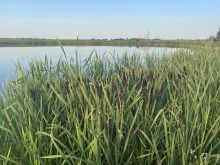FORBES, Australia – It is Monday afternoon and Adam Chudleigh and Tom Campbell should be out in the country talking with farmers and making livestock deals.
The two work as commissioned agents for Landmark Forbes, a division of AWB Ltd. that buys and sells livestock. They are among seven livestock agents in the Forbes region located about three hours north of Sydney.
“We are basically real estate agents for livestock,” said Campbell.
This is the fall season for Australia, when fewer cattle tend go to market.
Read Also

Europe holds promise for Canadian lentils
Pulse Canada is trying to help boost lentil consumption in Europe, which is already the fourth largest market.
“By rights, Monday should be our busiest day when we go out and do the cattle sales in the morning and in the afternoon we start drafting for the next day,” said Chudleigh, who has been an agent for four years.
Drought, however, has spread like an ink blot over southeastern Australia for the past seven years, acting as a drag on the cattle business.
A few recent rain showers lifted spirits so some farmers have decided to keep their cattle and sheep on the sparse grass a little longer rather than sell off stock. The quality arriving at the yards is variable, from those in good condition to those with ridges of ribs and bumpy spines jutting through dull looking hides.
These days most animals are going direct to slaughter. With forage and grain running out, few producers are interested in buying animals and fattening them on farm.
“Because it is so dry, there is not a lot of demand for store cattle at the moment,” said Campbell, referring to animals going back on grass.
Feedlot business is steady because they still have enough grain and byproducts, however high priced, to fatten stock for export.
Most of the trade in the Forbes area involves lambs, of which 70 percent go direct to slaughter and 30 percent are restocked on farms for further finishing.
Chudleigh and Campbell carry the tools of their trade in a briefcase full of sales reports, bright pink plastic tail tags, electronic ear tags and a tag applicator. Tags lost on consignments must be replaced immediately.
Cattle are individually identified but sheep have a curl lock plastic tag with the farmer’s farm identification code rather than individual numbers.
“When you have 30,000 sheep and lambs on the Tuesday sale, you would take three days to scan them all properly,” Chudleigh said.
Lambs are often sold on a grid basis where they must meet the right fat and muscle score as well as desirable weight and conformation. The grid is based on a scale of one to five with twos and threes being the most desirable. Premiums are not high, but discounts are greater, Campbell said.
Cattle prices are still holding, Chudleigh added, despite the drought and more people selling off stock.
Cattle and sheep are sold by the kilogram and by the cent rather than dollar basis.
Smaller calves are bringing 130 cents per kg while better cows sell for 50 to 80 cents per kg. Top cows could bring 130 cents a kg but they are seeing few of those these days.
Top quality grain fed steers sold on the hook, which means on the rail, are worth around 325 cents a kg on a hot carcass weight.
Selling directly to packers often cuts out the agent.
“With the cost of grain at the moment, the yard market prefers to sell on the hook,” Chudleigh said. “The direct market cuts us out straight away.”
Since they work with the markets every day, agents can advise farmers on trends. These days selling on the hook is the best deal.
Many of the cattle in this area are sold as short fed stock.
These receive a maximum of 60 days of grain and are sold to Australian supermarkets. The cattle are around 450 kg at slaughter.
“Those little calves are what the butchers like to kill,” Chudleigh said.
Export cattle may fall into the categories of medium fed at 120 days and long fed for more than 300 days. These may be Wagyu, Angus or Shorthorns fed for the Japanese or South Korean markets.
The cattle are much larger and Campbell shakes his head when asked to describe their appearance after such a long feeding period.
“They are pretty fat with a lot of marbling, but that’s what they want,” he said.
Most agents work with live sales but an electronic auction is also available, although not widely used. Owned jointly by Landmark and Elders Ltd., anyone can check the site at www.auctionsplus.com.au to find a description of breed, type, weight and other pertinent details and sale schedules. Photographs are often provided.
Sellers can withdraw if their reserve bid is not made, or some lots may be passed if there is not enough demand.
Acceptance among producers depends on individual interest but agents like Campbell often monitor the on-line bids while attending a live sale to compare prices and trends.















